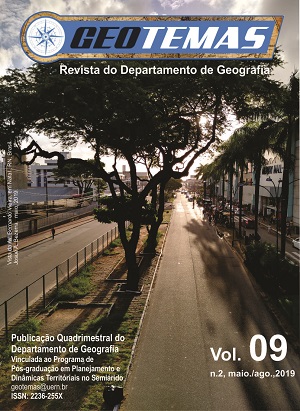The landscape of the city of Recife: a landscape analysis of old Recife neighborhoods - Santo Antônio and São José
Keywords:
Landscape, Recife, São José, Santo AntônioAbstract
Reflecting on the cultural landscape of the city of Recife brings out its history, spaces and territories relationship and, therefore, society. These are forms of incorporating cultural landscape, economic and political practices. We support Eric Dardel (2011, p. 30), when he states that "the landscape is a set, a convergence, a lived moment, an internal connection, an 'impression' that unites all the elements." It's about understanding cultural according to their representations and significations, with the purpose of apprehending the expressions of the landscape of the districts of Recife Antigo, Santo Antônio and São José of the city of Recife. The methodology used is embodied in the observation and analytical reading of the productions that deal with the theme. In this city, the landscape there is interactive mosaic units that allow us a possibility of observation. We assume the landscape as a whole considering the spatial interactions between natural and cultural units. It gives us the prospect of apprehending them while geographic and cultural expression in their multiple perspectives. The city had been modeled and revealed its structure and physiognomy. As a result, a new type of geographical landscape has been developed with rivers and bridges, mocambos and hills. Thus, the landscape of the capital of Pernambuco is composed of natural and human forms that constitute a heterogeneous set of river/ocean and urban/cultural. In this way, Old Recife is a city with breathtaking scenery that stands out for its features. That area corresponds to - Santo Antônio and São José "neighborhoods, well known as Navios and Antonio Vaz" -. The city is crossed by Capibaribe and Beberibe rives, and by the Atlantic Ocean that configure landscapes marked by the dialectic between the environment and the human products, in a noticeable scenario.
Downloads
References
CARTA FORAL DE OLINDA, 1537. Carta Foral de Olinda, Outorgada por Duarte Coelho. Outorgada por Duarte Coelho. Olinda, 1537.
CAVALCANTI, C. B. O Recife e seus bairros. Recife: Câmara Municipal, 1998.
CREA – Conselho Regional de Engenharia e Agronomia de Pernambuco. Arquitetura do bairro do Recife é marcada pela influência européia. Recife, 2009. Disponível em: <http://www.crea.org.br>. Acesso: 24 set. 2018.
FERREZ, G. Raras e preciosas vistas e panoramas do Recife: 1755-1855. Rio de Janeiro: Fundação Nacional Pró-Memória; Recife: Fundação do Patrimônio Histórico e Artístico de Pernambuco, 1984. (Coleção Pernambucana. 2ª fase).
GASPAR, J. O Retorno da paisagem í Geografia: apontamentos místicos. Finisterra, v. 36, n. 72, p. 83-99, 2001.
GASPAR, L. São José (Recife, bairro). Pesquisa Escolar Online, Fundação Joaquim Nabuco, Recife. Disponível em: <http://basilio.fundaj.gov.br/pesquisaescolar/> . Acesso em: set. 2018.
IBGE – Instituto Brasileiro de Geografia e Estatística. BIBLIOTECA ESCOLAR. Porto do Recife: 19--. Catálogo, ID: 40568. Código de Localidade: 2611606.
JORNAL DO COMERCIO. Arquitetura eclética nas ruas do Recife. Recife, 2015.
MELO, M. L. de. Metropolização e subdesenvolvimento: Caso do Recife. Recife: Universitária, 1978.
MELLO, J. A. G. de. Diário de Pernambuco. Economia e Sociedade no 2º Reinado. Recife: Editora Universitária da UFPE, 1996.
PREFEITURA DO RECIFE. Fundação do Recife. Carta Foral, 2016.
PINCHEMEL, P.; PINCHEMEL, G. La face de La Terre: elements de Geographie. 2. Ed; Paris: A. Collins, 1992.
SILVA. A. N. B., a dona do Carnaval de 1985 ela é de festa, ela é de religião! Anais... do Enc. Internacional e 26. Enc. de História da Anpuh: histórias e parcerias, 2018.
SILVA. A. N. B.. "Quem gosta de samba, bom pernambucano não é?" (1955-1972). Recife: Universidade Federal de Pernambuco (Mestrado em História), 2011.
SILVA, L. D. Apresentação. Rio de Janeiro: Fundação Nacional Pró-Memória; Recife: Fundação do Patrimônio Histórico e Artístico de Pernambuco, 1984. (Coleção Pernambucana. 2. fase).
Downloads
Published
How to Cite
Issue
Section
License
Authors who submit their manuscripts to Geotemas declare that the work is an original article and has not been submitted for publication, in full or in part, in another national or international scientific journal or in another circulation vehicle. The authors also declare that they agree with the transfer of the copyright of the referred article to the magazine Geotemas (University of the State of Rio Grande do Norte), allowing for later publications, as long as the source of its publication is assured. Finally, they assume public responsibility for the article, being aware that any charges arising from a claim by third parties regarding the authorship of the work may apply to them.



















